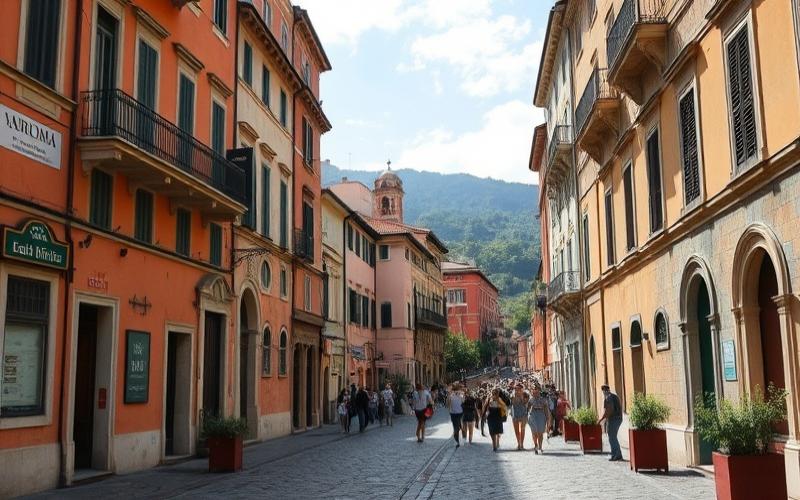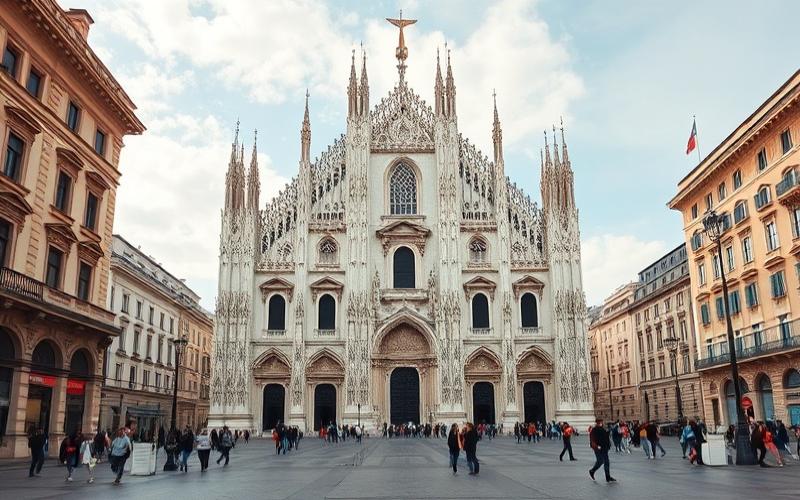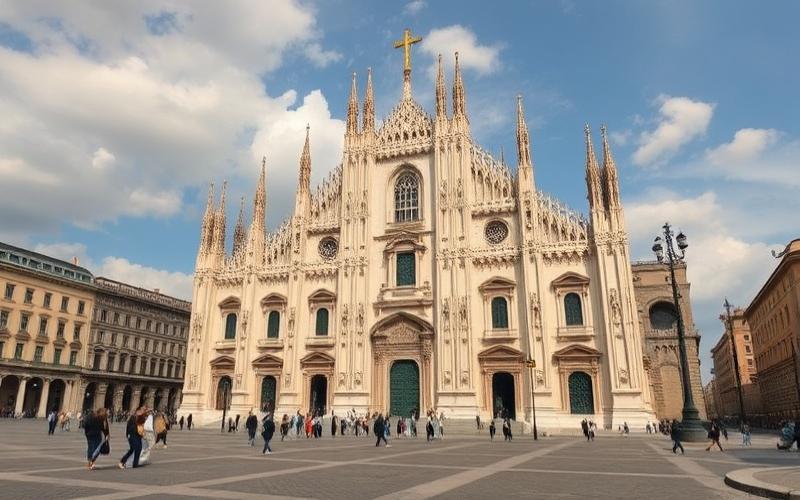
 Published on and written by Cyril Jarnias
Published on and written by Cyril Jarnias
Navigating the Italian real estate market can be challenging for property owners and agents seeking to maximize their property’s online visibility. Too often, listings suffer from oversights that hinder their success. Whether it’s poorly written descriptions, low-quality photographs, or the absence of relevant keywords, these mistakes can seriously compromise the chances of selling or renting a property. Knowing how to avoid these common pitfalls is essential to attract potential buyers’ attention and stand out in a competitive market.
In this article, we will explore the ten most frequent SEO mistakes and provide practical tips to optimize your listings, thereby ensuring better visibility and appeal in the market.
Optimizing Online Visibility for Real Estate Listings in Italy
Optimizing online visibility for real estate listings in Italy relies on a local SEO strategy, smart integration of Italian platforms, and a data-driven execution, adapted to the country’s linguistic and cultural specificities.
Local and Regional Targeting
- Prioritize SEO on Google.it with a proper multilingual structure (hreflang, local site architecture, native content) to address Italian local and regional queries.
- Adapt semantics to cultural and linguistic differences between regions (expressions, place names, dialects influencing queries) and align page taxonomy with local transactional intents.
- Develop proximity signals via local citations, Italian backlinks, and dedicated pages for target cities/neighborhoods.
Real Estate Keywords in Italy
- Conduct keyword research specific to Google.it, segmented by intent (informational, transactional, local) and by region, then map these terms to listing pages and local guides.
- Integrate common Italian variants (e.g., affitto, vendita, trilocale, bilocale, mutuo, prima casa) and long-tail queries combining property type + neighborhood + attributes (e.g., “attico vista mare Genova”).
- Use competitive data and SERP analysis to prioritize keywords with qualified traffic and conversion potential.
Local Real Estate Platforms and Specialized Search Engines
- Leverage high-traffic Italian portals for listing distribution and referral traffic generation, ensuring data consistency (titles, descriptions, prices, geolocation) and backlinks to owned pages.
- Integrate these platforms into the overall strategy: feed syndication, UTM tracking, profile optimization, and acquiring mentions/backlinks from Italian media/directories to strengthen authority on Google.it.
Relevant and Quality Content to Attract and Convert
- Produce native Italian content aligned with local expectations: enriched listing pages, neighborhood guides, market trends, local taxation, buying/selling processes, and practical checklists.
- Link editorial content to listing pages via thematic internal linking, structured FAQs, and enriched data, to improve visibility and capture qualified leads.
- Update regularly to reflect the dynamics of the Italian market and strengthen topical authority.
Social Media in Italy
- Utilize Facebook, Instagram, and LinkedIn for listing promotion and targeting by area, interests, and behaviors, adapting formats and messages to the Italian audience.
- Use short visual formats (Reels, carousels) for properties and social proof posts (testimonials, “just sold”) to build trust and drive traffic to the owned website.
- Synchronize social and SEO editorial calendars (article/listing launches, local seasonal campaigns), and track performance with UTMs.
Image and Video Optimization
- Compress and serve media in modern formats (WebP/AVIF), lazy loading, Italian alt tags including key attributes (neighborhood, property type), and image/video sitemaps for indexing.
- Adapt videos for platforms (Italian subtitles, chapters, local metadata), performant hosting, and lightweight integrations to preserve Core Web Vitals.
Mobile Experience
- Prioritize excellent mobile performance: responsive design, speed, clear navigation, simplified forms, clickable phone numbers, and local pages accessible in 1–2 clicks.
- Implement correct hreflang markup and URL structures by language/country to provide a consistent localized mobile experience on Google.it.
Measurement and Continuous Iteration
- Establish a measurement framework: GA4 + Search Console (Google.it), conversion tracking (forms, calls), and dashboards by region/portal/source.
- Track local keyword rankings, qualified traffic, conversion rates by content type and portal, then adjust content, interlinking, and distribution budgets accordingly.
Operational Control Panel
| Pillar | Key Actions | Main KPIs |
|---|---|---|
| Local Targeting | Hreflang, city/neighborhood pages, local citations | Local Google.it impressions, clicks, traffic share by region |
| Keywords | Intent mapping, local long-tail | Rankings, CTR, qualified traffic |
| Platforms | Syndication, profile optimization, backlinks | Referrals, platform leads, lead quality |
| Content | Local guides, FAQs, internal linking | Page views, average time, conversions |
| Social | Native formats, local targeting, UTMs | Reach, social traffic, CPL |
| Media | WebP/AVIF, Italian alt tags, sitemaps | Speed, image/video indexing |
| Mobile | Core Web Vitals, form UX | LCP/CLS/INP, mobile conversion rate |
| Analytics | GA4, GSC, regional dashboards | Leads, cost per lead, ROI |
To succeed in Italy, combine localized SEO on Google.it, a strong presence on national real estate portals, high-quality native content, and continuous data-driven iteration.
Actionable Checklist
- Deploy hreflang it-IT, structure /it/ folders, and create “neighborhood” pages with strong local intent.
- Perform Google.it keyword research and map each cluster to the right pages (listings, categories, guides).
- Syndicate listings to Italian portals, standardize data, add UTMs, and acquire backlinks from local profiles/press releases.
- Produce 2–4 local Italian content pieces/month and systematically link to relevant listings.
- Optimize media (WebP, Italian alt tags), image/video sitemaps, and improve mobile Core Web Vitals.
- Set up regional dashboards and a monthly optimization cycle based on rankings, qualified traffic, and conversion rates.
Good to Know:
To optimize the online visibility of real estate listings in Italy, it is crucial to adapt your SEO strategy to localization and regional targeting, taking into account Italian linguistic specificities; for example, using keywords such as “appartamento a Roma” or “villa in Toscana” can improve SEO. Integrating local platforms like Idealista or Immobiliare.it is essential to reach a wider audience, while ensuring that listing content is well-optimized with precise and engaging descriptions. Creating relevant content, such as blog articles on local market trends, can increase traffic and generate leads. Promotion on social media is also indispensable, with Facebook, Instagram, and LinkedIn being particularly effective for reaching an Italian audience. It is also beneficial to improve the quality of property images and videos to attract attention on search engines and social platforms. Finally, ensuring that listings are optimized for mobile devices is imperative, as mobile visits are booming in Italy, and using analytics tools to evaluate and adjust the visibility strategy guarantees continuously improved results.
Common SEO Mistakes in Italian Listings
Inadequate Keyword Usage
A poor choice of keywords (too generic like “apartment for sale” or misaligned with search intent) dilutes relevance and places your listings in direct competition with giant portals, which significantly reduces organic visibility.
Italy Example: targeting “appartamento in vendita Roma” remains too broad; prefer long-tail queries aligned with transactional intent and the neighborhood, such as “trilocale in vendita Prati vicino Metro Ottaviano” or “attico vista Duomo Firenze centro storico”.
Best Practices:
- Segment by property type, contract type, and distinctive features: “bilocale con balcone”, “box auto incluso”, “classe energetica A4”.
- Map keywords to the journey stage: information (“costi notaio acquisto prima casa Milano”), comparison (“migliori quartieri famiglie Bologna”), transaction (“monolocale economico Torino San Salvario”).
- Avoid keyword stuffing and prefer natural semantic variants in local Italian (neighborhoods, metro stops, postal codes).
Duplicate Content
Copy-pasting the same description across multiple portals and your site leads to cannibalization and ranking losses.
Example: the same listing “trilocale luminoso, vicino a tutti i servizi” published identically on Immobiliare.it, Idealista, and your site deprives your domain of differentiation and can delay indexing.
Best Practices:
- Write an original version for your site with unique details (2023 renovations, seismic certificates, energy class, condominium fees, stable year).
- Use structured fields and distinct descriptive snippets per portal.
- Implement canonical URLs on your site and a clear syndication plan.
Ineffective Title and Meta Description
Vague titles and generic meta descriptions reduce CTR and thus visibility.
Example: “Appartamento in vendita – Roma” is uninformative; prefer “Trilocale ristrutturato con terrazzo | Prati, Roma | 89 m², piano alto, ascensore”.
Best Practices:
- Title: property type + key feature + neighborhood/city + metrics (m², floor) + local USP.
- Meta description: concrete benefits and localized call to action: “A 300 m from Metro A Ottaviano, double bathrooms, habitable kitchen, ready for occupancy. HD photos and virtual tour.”
- Avoid unnecessary special characters; respect optimal lengths to avoid truncation.
Poor Mobile Optimization
Non-responsive or slow pages on smartphones penalize user experience and ranking, while real estate search in Italy is predominantly mobile.
Example: listings with heavy carousels and non-ergonomic forms drop conversions in Naples or Bari where mobile usage is dominant.
Best Practices:
- Responsive design, readable fonts, visible “Call/WhatsApp” contact buttons.
- WebP images, lazy loading for galleries, video compression for virtual tours.
- Avoid intrusive full-screen pop-ups; test with mobile Core Web Vitals.
Omission of Local Elements
Ignoring the local dimension reduces geographic reach and relevance for the Italian SERP.
Example: “appartamento Milano” is insufficient; include “Città Studi”, “Politecnico di Milano”, “linea M2 Piola”, “vicino Parco Sempione”, “codice di avviamento 20133”.
Best Practices:
- Integrate points of interest: universities, hospitals (San Raffaele), transport (Frecciarossa, tram 2), ZTL zones.
- Mention local regulations: classe energetica (A4–G), bonus ristrutturazione, sismabonus where applicable.
- Create category pages by neighborhood/municipality with internal linking to listings.
Insufficient Internal and External Links
Poor internal linking hinders indexing and listing discovery.
Example: a listing in Turin not linked to the “case in vendita San Salvario” page loses internal PageRank.
Best Practices:
- Internal links: listing → category (neighborhood), category → listing, similar listings (“altri trilocali in Prati”).
- Valuable external links: to transport plans (ATAC, ATM), municipal pages on IMU/TASI, when relevant, to strengthen trust.
- Structure breadcrumbs: Home > Vendita > Appartamenti > Roma > Prati.
Slow Page Load Times
Slow loading times increase bounce rates and harm SEO and leads.
Example: non-optimized galleries of 30 photos in Florence cause load times over 3 seconds on 4G; users leave before seeing the “Contact” button.
Best Practices:
- Optimize media (WebP/AVIF, sizing, Italian/EU CDN).
- Preload the main image, defer chat scripts and mortgage widgets.
- Implement server-side caching; regularly test on Italian mobile networks.
Ignoring Alt Tags for Images
Without descriptive alt tags, loss of accessibility and Google Images traffic opportunities.
Example: “IMG_1234.jpg” without alt; prefer alt: “Soggiorno con travi a vista, attico Prati Roma, terrazzo 20 m²”.
Best Practices:
- Describe the scene, room type, location, key feature.
- Avoid keyword stuffing; remain natural and precise.
- Name files consistently: “trilocale-prati-roma-soggiorno.jpg”.
Title Tags and Header Structure
Poor H1/H2/H3 hierarchy confuses search engines’ understanding of the content.
Example: multiple H1s on a listing (“Appartamento in vendita” and “Trilocale ristrutturato”) or total absence of H2s for sections (Caratteristiche, Zona, Spese).
Best Practices:
- A single descriptive H1: “Trilocale ristrutturato con terrazzo a Prati, Roma”.
- H2 for sections: “Caratteristiche”, “Posizione e servizi”, “Efficienza energetica”, “Documentazione”.
- Bullet lists for key assets; FAQ schema at the bottom of the page when relevant.
Neglect of Regular SEO Audits
Without audits, technical and strategic errors accumulate (broken links, redirects, indexed expired listings).
Example: old sold listings in Milan still indexed, generating a poor user experience signal and cannibalizing new ones.
Best Practices:
- Quarterly audit: indexability, cannibalization, internal linking, Core Web Vitals, crawl logs.
- Delisting process: 410 for removed listings, redirects to category if needed, updated sitemap.
- Track local SERPs by city/neighborhood and continuous improvement of titles/CTR.
Table of Concrete Examples for the Italian Market
| Mistake | Bad Example | Better Example |
|---|---|---|
| Keyword Usage | “Appartamento in vendita Roma” | “Trilocale ristrutturato con terrazzo Prati Roma vicino Metro A” |
| Title/Meta | Title: “Appartamento – Vendita” | Title: “Trilocale 89 m² con terrazzo | Prati Roma | Piano alto” |
| Local | “Zona centrale” | “A 300 m da Metro Ottaviano, vicino Via Cola di Rienzo, CAP 00192” |
| Images | Empty alt | alt: “Cucina abitabile con isola, attico Prati, vista Cupola” |
| Performance | 4.5 s LCP mobile | Improve seller description for better SEO |
Improve Seller Description for Better SEO
A well-optimized seller description is a central lever to improve the SEO of real estate listings in Italy, as it aligns content with buyer queries and strengthens relevance in the eyes of search engines, which increases visibility and click-through rates.
Integrate Relevant Keywords Related to the Italian Market
- Target queries combining property type + location + local attributes: “apartment for sale Rome Trastevere”, “seaview villa Liguria”, “renovated trullo Puglia”, “attico con terrazza Milan Navigli”.
- Add linguistic and local variants: Italian (appartamento, bilocale, vista mare, centro storico), bilingual if targeting international traffic (FR/EN/IT) to capture export traffic.
- Use intent expressions: “near metro”, “move-in ready”, “ideal rental investment”, “seismic/energy bonus”, “energy class A/B”.
Write a Detailed and Engaging Description
- Describe precisely: area, number of rooms, floor/elevator, exposure, energy class, fees, year/renovations, cadastral compliance, condominium, diagnostics, distance to beaches/transport/schools, view, noise, brightness, storage, parking.
- Highlight differentiating Italian attributes: authentic architectural elements (vaults, frescoes, cotto), historical character, proximity to UNESCO sites, centro storico, vista lago/mare, pertinenze (cellar, parking space), outdoor spaces (terrazza, giardino), compliance and available documents.
- Write in a narrative style focused on benefits: “Live the dolce vita on a south-facing terrace with a view of the Duomo”, while remaining factual to preserve credibility.
- Structure for scanning: short sentences, bullet lists, thematic paragraphs (property, building, neighborhood, transport, work/fees, taxation/energy).
Strengthen Emotional Involvement
- Use sensory and lifestyle triggers: brightness, quiet, scents of pine/lavender, sea glimpses, neighborhood rhythm, local market.
- Project uses: remote work, family, pied-à-terre, seasonal rental, retirement.
- Associate emotions and proofs: frame each promise with a verifiable fact (measurable view, distances, energy certificates).
Optimize for Local and International Search Engines
- On-page SEO:
- Main keyword within the first 160 characters, in the H1 title and subheadings.
- Attractive, unique title/meta description tags, with location and USP.
- Structured data schema.org/Offer/RealEstateListing/Place (price, area, address, geocoords, energyRating).
- Short and readable slugs: /sale/apartment-rome-trastevere-terrace.
- Optimized images: descriptive file names in IT/FR, localized ALT text, WebP, compression.
- Local SEO:
- Consistent NAP (name/agency, address, phone), integrated map, landmarks and neighborhoods.
- Neighborhood terms: rioni, frazioni, municipalità, transport proximity (Linea M1/M2, stazione).
- International:
- Multilingual version with hreflang tags (it, fr, en).
- Measure search volumes in target countries and adapt synonyms (penthouse/attico, old town/centro storico).
Key Elements to Include to Maximize Visibility
- Clear and differentiating title: type + neighborhood + unique selling point + metric (area/terrace/view).
- P1 oriented on intent: who, what, where, why (USP), soft CTA.
- List of standardized attributes:
- Area (m²), rooms, floor, elevator
- Energy (class, consumption), heating (autonomo/centralizzato)
- Outdoor (balcone/terrazza/giardino), parking (posto auto/box)
- Fees, property tax, condominium
- Work/renovations (year, warranty), compliance (agibilità, planimetria)
- Distances: metro, station, schools, beach, amenities
- Proofs: certificates, work date, cadastral references, plan, virtual tour link.
- Precise calls to action: viewing slots, available documents, offer conditions.
How These Practices Influence Ranking
- Increased topical relevance: exact match between local queries and content, which improves relevance score and CTR, strengthening positioning.
- Better user behavior: clear descriptions increase time on page, lower pogo-sticking and bounce rate, positive quality signals.
- Semantic enrichment: local terms and entities (neighborhoods, monuments) help engines contextualize the listing in the Italian ecosystem, favoring eligibility for the local pack and rich results.
- Structured data: eligibility for rich results (price, area, availability), improving visibility and CTR.
- Multilingual/hreflang: better fit for international searches, avoiding cannibalization and signal dilution between versions.
Common Mistakes to Avoid and Solutions
- Description plagiarism
- Risks: duplicate content, page deindexing, loss of visibility.
- Solutions: complete rewrite, addition of verifiable USPs, unique semantic fields (neighborhoods, landmarks, materials), variation of editorial angle between portals.
- Lack of details
- Risks: low relevance, repetitive questions, high bounce rate.
- Solutions: mandatory data checklists, structured forms, validation before publication, addition of plans, measurements, and documents.
- Over-optimization and keyword stuffing
- Risks: artificial reading, algorithmic penalties, lower conversion rate.
- Solutions: natural density, synonyms, readability test, reading aloud, focus on real benefits.
- Unverifiable promises
- Risks: loss of trust, disputes, bad reviews.
- Solutions: source each asset (measurements, certificates, distances), avoid absolute superlatives without proof.
- Forgetting structured data and media
- Risks: lack of rich snippets, reduced visibility.
- Solutions: schema.org implementation, image/video optimization, virtual tour with tags.
- Generic titles
- Risks: low CTR, increased competition.
- Solutions: integrate differentiating asset + neighborhood + key metric.
Reusable Structure Template
- Title: “Appartamento bilocale – Brera, Milano – terrazza 12 m², classe B”
- Hook: 2–3 lines with USP, precise location, target usage.
- Key details (list):
- Area, rooms, floor/elevator
- Condition/work, notable materials
- Energy, heating/air conditioning
- Outdoor, parking
- Fees, tax, condominium
- Distances (m, min) to transport/amenities
- Neighborhood and lifestyle: atmosphere, shops, monuments, green spaces.
- Proofs and media: plan, 3D/virtual tour, certificates, photo date.
- Conditions and process: availability, documents, viewing/offer procedures.
- Clear CTA.
Quick Pre-Publication Checklist
- Main keyword in title, P1, URL, meta, image ALT.
- Valid and up-to-date structured data (price, area, address, energyRating).
- Unique content ≥ 300–500 words, readable, benefit + proof oriented.
- Granular location (neighborhood, landmarks), quantified distances.
- Optimized media, descriptive captions and alt texts.
- Italian version and hreflang tags.
- Visible CTA and contact details, viewing hours.
- Unique variants per portal to avoid inter-site duplication.
| Element | SEO Impact | Best Practices | Example |
|---|---|---|---|
| Title/URL | CTR, relevance | Keywords + location + USP | “attico-roma-trastevere-terrazza-20m2” |
| Meta description | CTR | Benefit + proof + CTA | “Tiber view, class B, virtual tour – Book now.” |
| Structured data | Rich results | schema.org RealEstateListing | Price, area, energyRating |
| Content | Ranking | 300–800 unique words, local semantics | Centro storico, rioni, monuments |
| Media | Decision/CTR | ALT, WebP, compression | “terrazza-vista-duomo.webp” |
| Local | Local pack | NAP, map, landmarks | Near M2 Moscova (350 m) |
| International | Reach | Hreflang, bilingual glossaries | attico/penthouse |
Priority: unique content, verifiable proofs, technical structure (schema + hreflang) and strong localization.
Good to Know:
To optimize the seller description of a real estate listing in Italy and improve its SEO, it is crucial to include relevant keywords, such as those evoking specific aspects of the Italian real estate market, like “Tuscan villa” or “Roman apartment”. A detailed and engaging description, which sparks emotional involvement in the buyer, can significantly increase your property’s visibility on search engines, both local and international. Avoid plagiarism and lack of details, as this not only harms the listing’s ranking but also its credibility. Prefer an original approach by enriching your texts with precise details, such as the neighborhood’s history or nearby amenities, to offer a complete and authentic experience to your readers.
Using Keywords Effectively to Attract Attention on Airbnb
Using relevant and specific keywords in the title, description, and amenities sections of an Airbnb listing directly improves its visibility and ranking in search results, as the algorithm values relevance to traveler queries and listing completeness. A judicious choice of keywords attracts a targeted audience (travelers specifically seeking a type of accommodation, a location, or amenities) and increases click-through and conversion rates, signals that further strengthen the listing’s positioning.
Why Keywords Matter on Airbnb
- Airbnb ranks listings based on relevance, quality, and engagement criteria; complete and precise descriptions, structured around terms searched by travelers, are favored in results.
- Listing optimization best practices explicitly recommend identifying and integrating the most searched keywords for similar accommodations, in the title and body text.
- Highlighting location, proximity to tourist sites, and sought-after amenities matches traveler filters and search intents, improving the listing’s match with their queries.
Practical Examples of Targeted Keywords for Italy
Northern Italy
- Milan: “design apartment Brera”, “Loft Navigli with terrace”, “Duomo 5 min walk”, “near metro M1/M2”, “coworking space, Wi‑Fi 1 Gbps”.
- Lake Como: “lake Como view”, “Bellagio terrace”, “ferry access Varenna”, “private parking”.
Central Italy
- Florence: “Oltrarno craftsmanship”, “Ponte Vecchio 300 m”, “ZTL permit/garage”, “entire place with equipped kitchen”.
- Rural Tuscany: “Chianti agriturismo”, “stone house, pool, vineyards”, “near wine route”.
- Rome: “Trastevere quiet street”, “Colosseum 10 min bus”, “self check‑in 24/7”, “air conditioning, elevator”.
South and Islands
- Naples: “Spaccanapoli balcony”, “near metro Dante”, “historic pizzeria 50 m away”, “local cuisine, market”.
- Puglia: “Trullo Valle d’Itria”, “Pescoluse beach 10 min”, “Lecce baroque”, “parking, bike included”.
- Sicily: “Taormina sea view”, “Etna excursions”, “Isola Bella beach walkable”, “A/C, outdoor kitchen”.
- Sardinia: “Costa Smeralda beach walkable”, “turquoise water Cala Brandinchi”, “family stay, baby cot”.
Examples of Well-Optimized Listing Formulations
- “Duomo 5 min | Loft Navigli with terrace | Wi‑Fi 1 Gbps, self check‑in, near tram 2” — combines landmark, sought-after neighborhood, concrete benefit, and desired amenities.
- “Authentic Trullo with pool | Valle d’Itria | beach 15 min, private parking, ideal for families” — associates property type, region, attraction, and target usage.
- “Lake Como view | Bellagio center | balcony, parking, near ferry dock” — highlights view, micro-location, and mobility.
Where to Place Keywords to Maximize Impact
- Title: 1 to 2 major assets + 1 micro‑location + 1 differentiating amenity.
- First lines of description: benefit-oriented summary (place, property type, usage: family/remote work), aligned with traveler filters.
- Amenities and neighborhood sections: use the exact terms travelers filter or type (high-speed Wi‑Fi, parking, air conditioning, near metro, self check‑in).
- Photo captions: remind differentiating elements (view, walking distance, pool).
Common Mistakes by Italian Hosts and Solutions
- Too generic keywords (“beautiful apartment in Rome”) → Add neighborhood specifics, walking/minute distances, target uses (“Quiet Trastevere, Colosseum 10 min bus, ideal for remote work”).
- Title filled with non-searched adjectives (“magnificent, charming”) → Replace with places, distances, amenities, and numbers (“Wi‑Fi 1 Gbps, south balcony, elevator”).
- Forgetting micro‑locations and transport (“city center” without detail) → Mention stations, lines, walking times, parking, ferries.
- Inconsistency between keywords and reality (over-promising) → Prioritize accuracy and completeness; Airbnb favors reliable listings with good reviews and low cancellation rates.
- Neglecting sought-after amenities in filters → List explicitly and in a standardized way (air conditioning, baby cot, equipped kitchen, self check‑in).
- Not updating the listing → Complete and up-to-date listings are ranked better; revise keywords seasonally (e.g., “walkable beach”, “Christmas markets”).
Recent Data and Learnings from Real Estate SEO Applicable to Airbnb
- Airbnb optimization guides recommend identifying terms actually searched for similar accommodations and integrating them into the title, description, and tags to increase visibility and bookings.
- Key algorithm criteria include location, competitiveness, listing quality, and host performance; aligning content with these factors via concrete and verifiable keywords strengthens ranking.
- Listing best practices emphasize highlighting unique features and proximity to attractions, which translates into high-intent location and usage keywords.
- During the Italian high season, performing marketing strategies rely on seasonality and local demand; adapting keywords to the calendar and regional events improves relevance and conversion rates.
Quick Keyword Optimization Checklist
- Identify 10–20 queries specific to the property: type + micro‑location + attraction + amenity.
- Build a 60–70 character title with 3 strong, measurable elements.
- Open the description with 3 benefits aligned with traveler filters.
- Standardize amenity and transport names.
- Update seasonally and after each improvement (e.g., addition of A/C, new parking).
Examples of Seasonal Keywords for Italy
- Summer: “walkable beach”, “umbrella/2 sunbeds included”, “ferries Aeolian Islands”, “air conditioning”.
- Winter: “Bolzano Christmas markets”, “near Dolomites, ski shuttle”, “independent heating”.
Key takeaway: align your keywords with traveler intent (precise location, nearby attractions, stay purpose, filtered amenities). Observable and measurable relevance is a direct lever for visibility and ranking on Airbnb.
Good to Know:
Using relevant keywords is crucial to boost the visibility of Airbnb listings in Italy. Owners can stand out by choosing precise terms that reflect their rental’s assets and location, such as “Tuscan villa with pool” or “cozy apartment in Rome near the Colosseum”. A recent study shows that listings integrating keywords adapted to their region record a higher click-through rate and better ranking in search results. Common mistakes include using overly generic terms or forgetting to include specific property characteristics. To optimize visibility, owners should analyze high-performing keywords in their area and regularly update their listing, draw inspiration from offers receiving many bookings, and ensure to avoid keyword overloading which can seem unnatural.
Disclaimer: The information provided on this website is for informational purposes only and does not constitute financial, legal, or professional advice. We encourage you to consult qualified experts before making any investment, real estate, or expatriation decisions. Although we strive to maintain up-to-date and accurate information, we do not guarantee the completeness, accuracy, or timeliness of the proposed content. As investment and expatriation involve risks, we disclaim any liability for potential losses or damages arising from the use of this site. Your use of this site confirms your acceptance of these terms and your understanding of the associated risks.













































